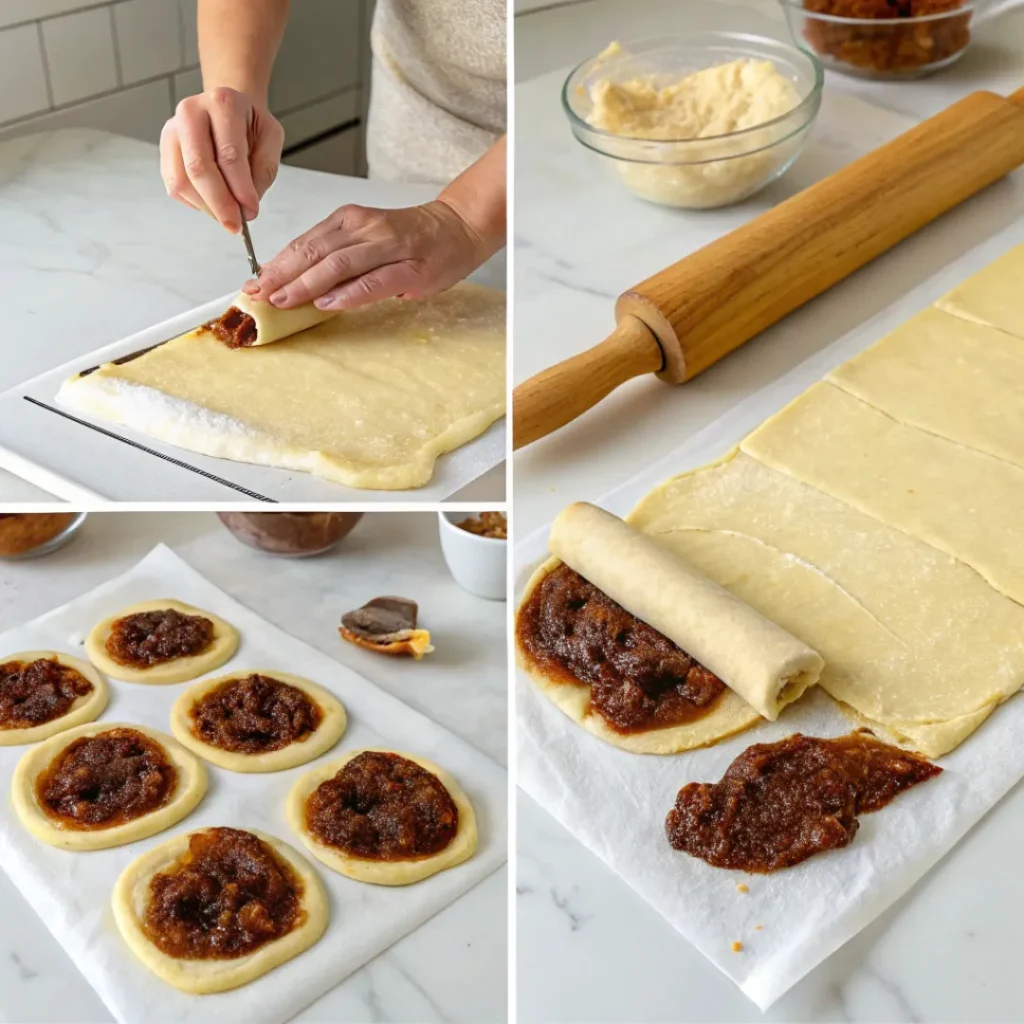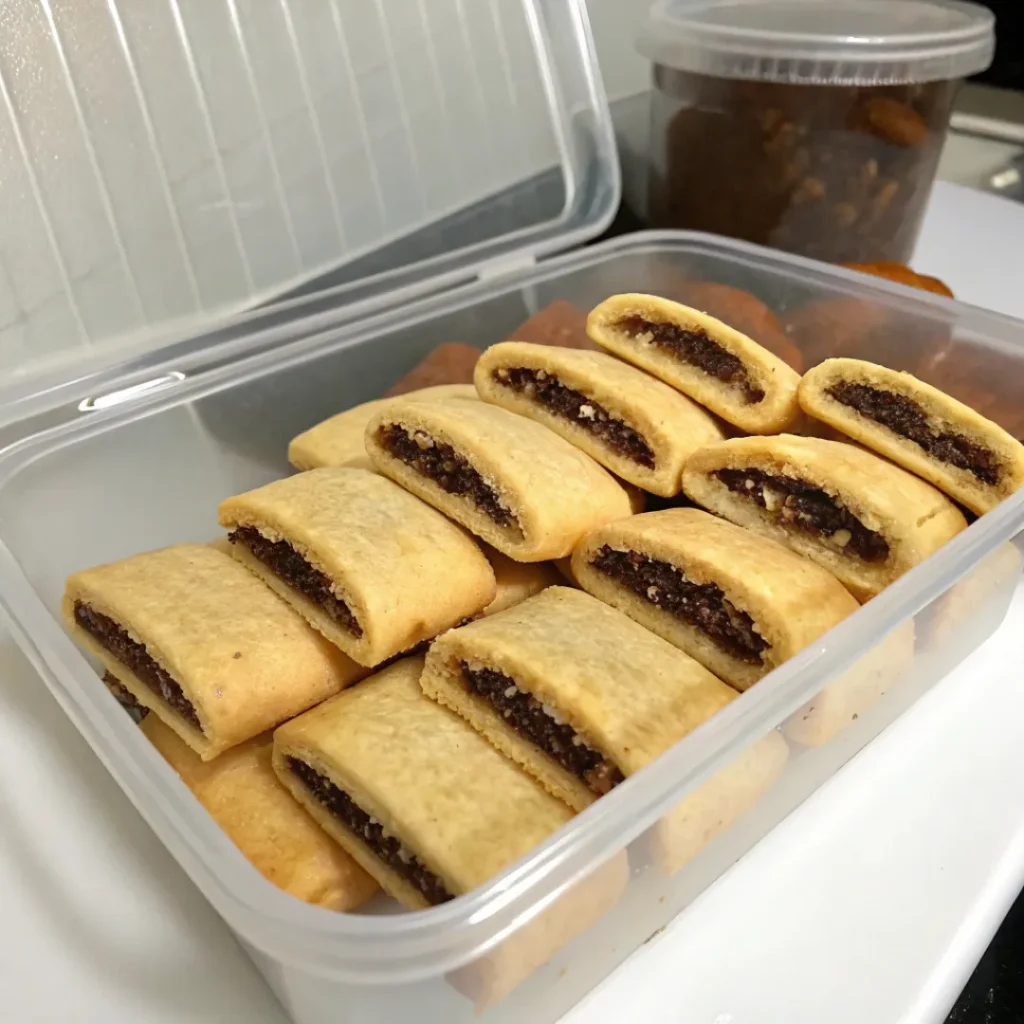Homemade Fig Newtons aren’t just nostalgic; they’re deliciously rewarding when baked from scratch. If you’ve ever wondered how to recreate this chewy, fruity cookie with its signature fig filling and soft biscuit-like dough, you’re in the right place. In this article, we’ll walk you through every step of making homemade fig newtons using real ingredients like dried figs, citrus zest, and warm spices. We’ll cover the origin of the fig filling, discuss health aspects, and answer common questions about fig cookies—including those persistent myths about wasps. Whether you’re an avid home baker or just cookie-curious, we’ve crafted this guide to be practical, informative, and tasty.
History and Origin of Homemade Fig Newtons
The Birth of the Classic Newton
Homemade Fig Newtons are the handcrafted evolution of a beloved American cookie that dates back to the late 19th century. The original Fig Newton was created in 1891 by the Kennedy Biscuit Works (which later became Nabisco) in Newton, Massachusetts—hence the name. It was marketed as a “health cookie,” combining sweet dried figs and a soft pastry that resembled cake more than a traditional cookie.
Over time, the fig newton became a household staple, appreciated for its chewy texture, sweet-tart fig filling, and the nostalgia it evoked. But commercial versions often contain added preservatives and refined sugars. That’s where homemade fig newtons shine: they allow you to honor the original intent while using fresh, wholesome ingredients that you can pronounce and trust.
From Factory to Kitchen: Why Go Homemade?
Making fig newtons from scratch isn’t just a culinary flex—it’s a flavor upgrade. Store-bought fig cookies have their place, but they can never match the complexity of a filling made from real dried figs, citrus zest, and natural sweeteners.
When you make homemade fig newtons, you control the sweetness, the texture, and even the spice blend. Want to add a hint of cinnamon or cardamom? You can. Prefer orange zest over lemon? Totally up to you.
Plus, the DIY version skips the additives and focuses on real ingredients. The process is simple: make a quick fig paste, whip up a buttery dough, shape and bake—and you’ve got a cookie that’s fresher, softer, and healthier than anything in a box.
Looking for inspiration? Try Banana Chocolate Chip Cookies if you enjoy unique cookie blends that push flavor boundaries.
Fig Filling – The Heart of Every Homemade Fig Newton
What’s in the Traditional Fig Newton Filling?
The filling is the soul of every homemade fig newton. It’s chewy, naturally sweet, and full of fruity richness. Traditionally, fig newtons are filled with a thick paste made from dried figs, gently simmered until they break down into a spreadable consistency. In this homemade version, we skip any artificial additives and alcohol, focusing only on whole food ingredients.
Here’s what you’ll need for the perfect homemade fig paste:
- Dried figs (14 oz) – remove stems and slice for faster cooking
- Orange juice – adds citrusy brightness
- Water – softens the figs and blends the mixture
- Brown sugar – deepens the sweetness with subtle molasses notes
- Lemon or orange zest and juice – balances out the richness with refreshing acidity
This simple blend turns into a thick, jam-like filling that’s naturally fiber-rich and full of flavor.
If you’re short on time or prefer a simpler method, you can use a thick, high-quality fig jam as a shortcut for the filling—just make sure it doesn’t contain added pectin or preservatives. We recommend this clean and easy homemade fig jam recipe by Marisa Moore, which uses wholesome ingredients and no additives.
How to Make a Thick, Flavorful Homemade Fig Paste
The process is straightforward and quick. Place your sliced dried figs in a saucepan and add 1/4 cup orange juice, 1/4 cup water, 2 tablespoons of brown sugar, and the juice and zest of one citrus—either lemon or orange.
Here’s how it goes:
- Cover the pan and bring to a boil.
- Lower the heat and simmer for 20 minutes, stirring occasionally. If the figs are especially dry, you can add a tablespoon or two of extra water to keep the mixture moist.
- Once the figs are fully softened and most of the liquid has been absorbed, remove from heat.
- Let the mixture cool slightly, then transfer to a food processor and blend until completely smooth.
You now have a thick, naturally sweet fig filling with no artificial flavors or alcohol.
Store the paste in an airtight container in the fridge for up to 7 days, or use immediately by transferring to a piping bag for easy portioning.
Here’s a quick visual table for your filling:
| Ingredient | Amount |
|---|---|
| Dried figs | 14 oz (400 g) |
| Orange juice | 1/4 cup (60 ml) |
| Water | 1/4 cup (60 ml) |
| Brown sugar | 2 tbsp (25 g) |
| Lemon/orange juice + zest | From 1 citrus fruit |
Don’t miss our Pumpkin Chocolate Chip Cookies for another soft, fruity dessert idea.
Ingredient Breakdown – What You’ll Need
Dry Figs, Citrus Zest & Orange Juice: Flavor Essentials
For your homemade fig newtons, start with clean, simple, and real ingredients. The focus here is on flavor, natural sweetness, and digestibility. At the heart of the filling are dried figs—the perfect blend of fiber-rich fruit and chewy satisfaction. You’ll want to use around 14 ounces (about 2–3 cups) of sliced dried figs, with stems removed.
Instead of alcohol, we use orange juice and water to soften the figs and bring out their natural flavor. Add a splash of fresh lemon juice and zest (or orange zest) to balance sweetness with a refreshing tang. This citrus blend makes the fig paste brighter, more fragrant, and family-friendly.
Here’s your simplified fig filling list:
- 14 oz dried figs (stems removed, sliced)
- 1/4 cup orange juice
- 1/4 cup water
- 2 tbsp brown sugar
- Juice and zest of 1 lemon or small orange
This combo delivers everything a good fig filling needs—richness, depth, and a citrus lift—without the need for any artificial flavors or alcohol.
Cookie Dough Must-Haves: Butter, Sugar, and Spice
While the fig filling steals the spotlight, the dough is your stage. This soft-baked cookie shell wraps the filling like a buttery blanket and is key to getting that nostalgic Fig Newton bite.
Your cookie dough essentials:
- Unsalted butter (1/2 cup) at room temperature, for that melt-in-your-mouth texture
- Granulated sugar (1/4 cup) and packed brown sugar (1/4 cup) to add sweetness and caramel tones
- Egg yolks (2) for richness and moisture
- All-purpose flour (1 3/4 cups) as your base
- A touch of baking soda (1/4 tsp) for subtle lift
- A pinch of salt (1/4 tsp) to balance the sweetness
- Vanilla extract (1 tsp) for warmth
- Optional: 1/2 tsp cinnamon or cardamom for a hint of spice
Here’s a quick reference table:
| Ingredient | Amount |
|---|---|
| Butter (room temp) | 1/2 cup (113 g) |
| Granulated Sugar | 1/4 cup (50 g) |
| Brown Sugar (packed) | 1/4 cup (53 g) |
| Egg Yolks | 2 |
| Vanilla Extract | 1 tsp |
| All-Purpose Flour | 1 3/4 cup (250 g) |
| Baking Soda | 1/4 tsp |
| Salt | 1/4 tsp |
| Optional Spice (Cinnamon/Cardamom) | 1/2 tsp |
Each of these ingredients works together to create a dough that is soft yet sturdy enough to hold a generous helping of fig filling without falling apart.
Step-by-Step Fig Newton Filling Preparation

Simmering the Figs to Perfect Softness
To make the best homemade fig newtons, start by transforming dried figs into a luscious, spoonable filling. This process doesn’t require any fancy ingredients—just orange juice, water, a touch of brown sugar, and fresh citrus zest and juice.
Here’s your step-by-step guide to perfect fig paste:
- Prepare the figs: Remove stems from 14 oz dried figs and slice them to help them cook faster.
- Add to saucepan: Place sliced figs into a medium pot. Pour in 1/4 cup orange juice, 1/4 cup water, and 2 tbsp brown sugar.
- Add citrus: Zest and juice one small lemon or orange, and stir into the pot.
- Simmer covered: Cover with a lid and bring the mixture to a gentle boil over medium heat. Once boiling, reduce to low and simmer for about 20 minutes, or until the figs are very soft and plump.
Need more moisture? Add 1 tablespoon of water at a time if the mixture begins to dry before the figs fully soften.
This slow simmer helps infuse the figs with citrus and sugar, breaking them down without making them watery. The result is a thick, naturally sweet filling that’s bright and flavorful.
Blending and Storing Homemade Fig Paste
Once your figs are fully softened and fragrant, remove them from the heat. Allow the mixture to cool for about 5 minutes, then transfer to a food processor or high-powered blender.
Blend until smooth—the texture should be thick but spreadable, like a fruit jam. If it seems too thick to blend, you can add a small splash of water or orange juice to loosen it slightly.
Storage tips:
- Transfer the paste to a container with a tight-fitting lid or a piping bag.
- Store in the refrigerator for up to 7 days.
- Bring to room temperature before using to make spreading easier.
You now have the star ingredient for your homemade fig newtons—rich, natural, and alcohol-free fig filling.
Making the Dough for Homemade Fig Newtons
How to Make the Best Cookie Dough for Homemade Fig Newtons
If you want your homemade fig newtons to taste better than store-bought, the dough is just as important as the fig filling. This soft, tender dough wraps around the fruity center, creating that classic bite you know and love. The goal? A cookie that’s slightly chewy, never dry, and just sweet enough to complement the figs.
To start your homemade fig newtons dough, cream together:
- ½ cup unsalted butter, softened at room temperature
- ¼ cup granulated sugar
- ¼ cup packed brown sugar
Use a hand or stand mixer and beat for 3 to 5 minutes until the mixture becomes light and fluffy. This step adds air into the dough, which helps create the soft texture that fig newtons are famous for.
Next, mix in:
- 2 egg yolks (they add moisture without making the dough runny)
- 1 teaspoon vanilla extract
Once fully combined, it’s time to add your dry ingredients.
In a separate bowl, sift together:
- 1¾ cups all-purpose flour
- ¼ teaspoon baking soda
- ¼ teaspoon salt
- Optional: ½ teaspoon cinnamon or cardamom for added warmth
Slowly mix the dry ingredients into your butter mixture until a soft dough forms. The dough should be smooth, soft, and not sticky. If the mixture is too wet, sprinkle in a bit of flour. If it’s too dry, add a small splash of milk or water to adjust the consistency.
Now, here’s a key step for all homemade fig newtons:
Shape the dough into a flat disk, wrap it tightly in plastic wrap, and refrigerate for 30 minutes. This rest period makes the dough easier to handle and helps the flavors come together.
Tips for Working with Soft Dough When Making Homemade Fig Newtons
Since fig newton dough is soft and slightly delicate, here are a few tricks to keep it smooth and easy to roll:
- Divide the dough into 6 even portions—this makes rolling more manageable.
- Place a portion of dough between two sheets of plastic wrap or parchment paper.
- Roll the dough into a rectangle measuring approximately 4 inches wide by 10 inches long. This size is ideal for folding over the fig filling.
- Keep unused portions of dough chilled until you’re ready to shape them.
Avoid adding too much flour when rolling—too much flour can dry out the dough and make your homemade fig newtons crumbly instead of soft.
Want to know the secret behind chewy cookies like these? Don’t miss our helpful post on Should I Melt the Butter When Baking Cookies?
Shaping and Filling the Homemade Fig Newtons

How to Shape Homemade Fig Newtons Like a Pro
Once your dough is chilled and your fig filling is smooth and thick, it’s time to bring your homemade fig newtons to life. This is the part where everything comes together—the soft cookie shell hugging the sweet fig paste in a perfect golden rectangle.
Here’s how to do it step-by-step:
- Divide your cookie dough into 6 equal pieces. Keep the ones you’re not using in the fridge so they stay cool.
- Place one piece of dough on a sheet of plastic wrap or parchment paper.
- Flatten it slightly, place another piece of plastic on top, and roll it out to form a rectangle about 4 inches wide and 10 inches long.
- Trim the edges to get clean sides—this will help the fig newtons bake evenly and look more professional.
This thin rectangle is your canvas. The goal is to get a wide enough strip to fold around the filling easily. Keeping the dough cool makes it less sticky and easier to manage.
Filling and Folding Homemade Fig Newtons with Ease
Once your dough is rolled out, grab your homemade fig filling—remember, no liqueur or alcohol here, just real fruit, citrus, and natural sweetness.
- Transfer the fig filling to a piping bag or plastic zip-top bag with the corner snipped.
- Pipe a thick line of filling right down the center of your rectangle. Aim for a line about ¾ inch wide and evenly distributed.
Now, use the plastic wrap to help fold one side of the dough over the filling. Press gently to flatten the paste underneath. Then fold the opposite side over the top, overlapping slightly to seal the seam.
Carefully flip the filled log seam-side down so the folds stay in place while baking.
Using a sharp knife or bench scraper, cut the log into smaller pieces, about 1½ to 2 inches long. These are your finished homemade fig newtons, ready for baking.
Want to keep them in bar form? You can also bake the entire log and slice it afterward—this method helps maintain even moisture.
Need more cookie inspiration? Check out our Pumpkin Chocolate Chip Cookies for another fruit-forward, soft-baked treat.
Baking to Golden Perfection
How to Bake Homemade Fig Newtons the Right Way
At this stage, your homemade fig newtons are shaped, filled, and ready to hit the oven. Now it’s all about baking them to a soft, golden finish—just like the ones you remember from childhood, but fresher, healthier, and entirely from scratch.
To get the perfect bake:
- Preheat your oven to 350°F (180°C).
- Line a baking sheet with parchment paper or a silicone mat to keep the dough from sticking.
- Carefully arrange your fig-filled cookies seam-side down on the tray, leaving just a bit of space between each piece.
Whether you sliced them before baking or kept them as whole logs, this step ensures your homemade fig newtons bake evenly and maintain their shape.
Bake for 10 to 13 minutes, until the bottoms turn a light golden color. The tops should remain soft—remember, fig newtons aren’t crunchy cookies. They’re meant to be tender and cake-like.
If baking full logs:
- Bake for 15 to 17 minutes until the top feels set and the bottom is lightly browned.
- Let them cool for 10 minutes, then slice into individual bars.
Cooling and Storing Homemade Fig Newtons for Maximum Softness
Once your homemade fig newtons come out of the oven, let them sit on the baking tray for about 5 minutes to firm up slightly. Then transfer them to a cooling rack to cool completely.
As they cool, something magical happens—the cookie dough softens, the fig center sets, and the flavors meld into the perfect nostalgic treat.
Want to enjoy them later? Here’s how to store them:
- Store the cookies in an airtight container at room temperature for up to 5 days.
- For extended storage, freeze the cookies for up to 2 months. Let them thaw at room temperature before serving.
Pro tip: The texture actually improves after a day or two as the moisture from the fig filling softens the cookie shell even more—just like classic fig newtons.
Looking for other cookie recipes that age beautifully? Don’t miss our chewy Banana Chocolate Chip Cookies that also get better with time.
Storage Tips and Cookie Longevity for Homemade Fig Newtons

How to Store Homemade Fig Newtons and Keep Them Fresh
After all your work crafting the perfect homemade fig newtons, the last thing you want is for them to dry out or lose their soft, chewy texture. Storing them correctly helps preserve their moisture, flavor, and structure so you can enjoy these nostalgic treats for days—or even weeks.
Here’s how to keep your homemade fig newtons tasting bakery-fresh:
- Let cookies cool completely before storing. Warm cookies release moisture that can make them soggy in a closed container.
- Place them in an airtight container lined with parchment paper to keep them from sticking to each other.
- Store at room temperature in a cool, dry place for up to 5 days.
These fig-filled cookies actually get softer and more flavorful the day after baking, as the fig paste infuses the cookie dough with even more moisture and sweetness.
If you prefer to make a large batch of homemade fig newtons in advance, freezing is your best option.
Can You Freeze Homemade Fig Newtons?
Absolutely! One of the great things about homemade fig newtons is how well they hold up in the freezer. Whether you want to save a few for later or meal prep your snack drawer, freezing these fig cookies keeps them fresh without compromising texture.
Here’s how to freeze them the right way:
- Allow cookies to cool completely.
- Arrange them in a single layer on a baking sheet and flash freeze for 30 minutes.
- Transfer frozen cookies to a freezer-safe bag or container with parchment between layers.
Freeze homemade fig newtons for up to 2 months. When you’re ready to enjoy them, just take them out of the freezer and let them thaw at room temperature for 1–2 hours. The fig filling will regain its softness, and the cookie shell will stay tender.
Want to add some variety to your baking stash? Discover great ideas like Chocolate Hazelnut Crunch Cookies that also freeze beautifully.
Fig Newtons and Your Health – Myths and Facts
Are Homemade Fig Newtons Actually Healthy?
If you’re wondering whether homemade fig newtons are a healthier option than store-bought, the answer is a confident yes. When you make fig newtons at home, you’re in control of every ingredient—no preservatives, no artificial flavors, and absolutely no processed sugars if you choose to keep it clean.
Here’s why homemade fig newtons are the better choice:
- Natural fiber: Dried figs are rich in dietary fiber, which helps support digestion and may relieve constipation.
- No high-fructose corn syrup: Unlike packaged versions, homemade fig newtons use real fruit and modest sweeteners like brown sugar or natural fruit juices.
- Citrus benefits: The lemon or orange juice and zest not only add flavor but also provide antioxidants and vitamin C.
Plus, you can reduce sugar or swap in gluten-free flour or alternative sweeteners if you need to adjust for dietary preferences. Whether you’re baking for your family or meal-prepping healthy snacks, homemade fig newtons deliver balanced nutrition in every bite.
Do Fig Newtons Contain Wasps or Bugs?
This is one of the most common myths about figs—and it’s time to put it to rest. No, your homemade fig newtons do not contain wasps, bugs, or insect parts. Here’s the truth behind the confusion:
Some wild fig species do rely on wasps for pollination, but the dried figs sold for baking are thoroughly processed, cleaned, and sorted before they ever reach your kitchen. Plus, the varieties typically used in recipes—like Mission or Smyrna figs—are cultivated in ways that don’t involve insect pollination.
So if you’ve been hesitant to try making your own homemade fig newtons because of this myth, you can rest easy. There are absolutely no wasps in your cookies—just natural, fruity goodness.
Which Figs Are Best for Homemade Fig Newtons and Digestion?
When it comes to choosing the best figs for your recipe, here’s what you need to know:
- Mission figs: These are dark, sweet, and ideal for making fig paste. They’re also high in fiber, making them great for digestion.
- Smyrna figs: Slightly lighter in color and flavor, but just as effective in fig fillings.
Both types are loaded with dietary fiber and antioxidants, and both work beautifully in any homemade fig newtons recipe. If you’re dealing with constipation, dried figs—especially Mission figs—are known for their natural laxative properties.
Want to explore more about cookie myths and facts? Don’t miss our fun take on What Is the Most Liked Cookie in the World?
Frequently Asked Questions
What is the filling made of in fig newtons?
The filling in traditional fig newtons is made from dried figs, often combined with citrus juice, zest, and a sweetener like brown sugar. In homemade fig newtons, this mixture is simmered and blended into a thick, smooth paste—completely alcohol-free and naturally sweet.
Are fig newtons actually healthy?
Homemade fig newtons are a healthier option compared to packaged varieties. They’re made with real fruit, natural sweeteners, and no preservatives. Figs are high in fiber and contain antioxidants, which support digestion and overall wellness.
Do all fig newtons have wasps in them?
No, homemade fig newtons do not contain wasps. The myth comes from certain fig species that rely on wasp pollination, but the dried figs used in baking are cultivated and processed in ways that eliminate any insect material. Your cookies are safe and clean.
What kind of figs are used in fig newtons?
Common choices include Mission figs and Smyrna figs. Mission figs are sweeter and darker, making them ideal for the rich, chewy filling in homemade fig newtons. Both varieties blend well when cooked and pureed.
Conclusion
Baking homemade fig newtons from scratch is more than a recipe—it’s a rewarding experience. You start with simple, whole ingredients like dried figs, citrus juice, brown sugar, and butter. You shape a soft, tender dough around a naturally sweet filling, bake until golden, and end up with a cookie that tastes fresher, softer, and healthier than anything store-bought.
Print
Homemade Fig Newtons Recipe
- Total Time: 1 hour 15 minutes
- Yield: 24 cookies 1x
- Diet: Vegetarian
Description
Soft and chewy homemade fig newtons made with real dried figs, citrus zest, and a buttery cookie dough. No alcohol. No preservatives. Just natural flavor.
Ingredients
14 oz dried figs, stems removed and sliced
1/4 cup orange juice
1/4 cup water
2 tbsp brown sugar
Juice and zest of 1 lemon or orange
1/2 cup unsalted butter, softened
1/4 cup granulated sugar
1/4 cup packed brown sugar
2 egg yolks
1 tsp vanilla extract
1 3/4 cups all-purpose flour
1/4 tsp baking soda
1/4 tsp salt
1/2 tsp cinnamon or cardamom (optional)
Instructions
1. In a saucepan, combine figs, orange juice, water, brown sugar, and citrus zest and juice.
2. Bring to a boil, then simmer for 20 minutes until figs are soft and liquid is mostly absorbed.
3. Let the mixture cool, then blend until smooth to form the fig paste.
4. Cream butter with both sugars until light and fluffy. Add egg yolks and vanilla extract.
5. Sift flour, baking soda, salt, and spice (optional). Mix into the butter mixture gradually.
6. Wrap the dough and chill for 30 minutes.
7. Divide chilled dough into 6 pieces. Roll into rectangles between two sheets of plastic wrap.
8. Pipe fig filling down the center. Fold sides over to enclose filling. Flip seam-side down.
9. Cut into 1.5–2 inch cookies or bake as a whole log.
10. Preheat oven to 350°F (180°C). Bake for 10–13 minutes until bottoms are golden.
11. Let cool on the tray for 5 minutes, then transfer to a cooling rack.
12. Store in airtight container or freeze for later.
Notes
Cookies will become softer after 1–2 days.
You can bake the logs whole and slice them after cooling.
Use orange zest for a sweeter flavor or lemon zest for more brightness.
Keep unused dough chilled between shaping for best texture.
- Prep Time: 40 minutes
- Cook Time: 13 minutes
- Category: Dessert
- Method: Baking
- Cuisine: American
Nutrition
- Serving Size: 1 cookie
- Calories: 98
- Sugar: 9g
- Sodium: 45mg
- Fat: 3.5g
- Saturated Fat: 2g
- Unsaturated Fat: 1.2g
- Trans Fat: 0g
- Carbohydrates: 17g
- Fiber: 1.2g
- Protein: 1.1g
- Cholesterol: 18mg

